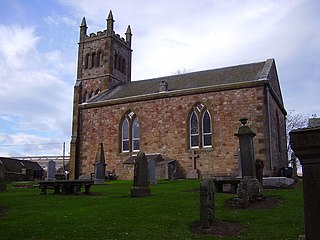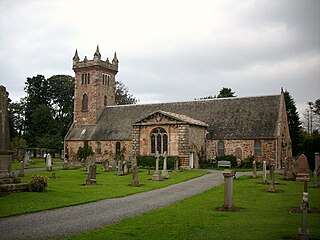Related Research Articles
Haliburton or Halliburton may refer to:
The Battle of Nesbit Moor was a small but significant clash between Scottish and English forces in the borders area north of the River Tweed. Specifically this clash took place on the Kimmerghame Estate in a field now named Slaughter Field. The estate is in the possession of the Swinton Family.
William Ruthven, 2nd Lord Ruthven was a Scottish nobleman. He served as an Extraordinary Lord of Session and Keeper of the Privy Seal.
Patrick Ruthven, 3rd Lord Ruthven played an important part in the political intrigues of 16th century Scotland. He succeeded to the lordship in December 1552. The Ruthven lordship encompassed the offices of Provost and Constable of Perth, and Sheriff of Strathearn.

Dirleton is a village and civil parish in East Lothian, Scotland approximately 20 miles (32 km) east of Edinburgh on the A198. It contains 7,500 acres (30 km2). Dirleton lies between North Berwick (east), Gullane (west), Fenton Barns (south) and the Yellowcraigs nature reserve, Archerfield Estate and the Firth of Forth (north). Gullane parish was joined to Dirleton parish in 1612 by an Act of Parliament because "Golyn is ane decaying toun, and Dirleton is ane thriven place."

Dirleton Castle is a medieval fortress in the village of Dirleton, East Lothian, Scotland. It lies around 2 miles (3.2 km) west of North Berwick, and around 19 miles (31 km) east of Edinburgh. The oldest parts of the castle date to the 13th century, and it was abandoned by the end of the 17th century.

Bolton is a hamlet and the third smallest parish in East Lothian, Scotland. It lies approximately 2 miles (3.2 km) south of Haddington and 20 miles (32 km) east of Edinburgh, and is an entirely agricultural parish, 6 miles (9.7 km) long by about 1.25 miles (2.01 km) wide. The most notable buildings in the hamlet are the Parish Church, an 18th-century dovecote or "doo'cot" and the former Bolton Primary School, which now serves as the village hall.

Sir Walter de Haliburton, 1st Lord Haliburton of Dirleton, Lord High Treasurer of Scotland was a Scottish noble.

Dirleton Kirk is a church in the village of Dirleton, in East Lothian, Scotland.
George Home, 4th Lord Home was a Scottish nobleman and Warden of the Eastern March.
Margaret Graham, Countess of Menteith was a Scottish noblewoman. She held the title Countess of Menteith in her own right, having inherited the title c. 1360 from her mother, Mary, Countess of Menteith, who was married to Sir John Graham. Graham was styled Earl of Menteith during his marriage with Mary, whom he predeceased. The Menteith region was situated partially in southwest Perthshire and partly in Stirlingshire.
The Battle of Nesbit Moor was an engagement fought in August 1355 between forces of the Kingdom of Scotland and the Kingdom of England.
Lord Haliburton of Dirleton was a Scottish Lordship of Parliament created circa. 1450 for Sir Walter de Haliburton, Lord High Treasurer of Scotland. The seat of Lord Haliburton was at Dirleton Castle in present-day East Lothian.
George Haliburton, 4th Lord Haliburton of Dirleton, was a Scottish Lord of Parliament.
James Halyburton of Pitcur was a Scottish landowner and politician.
The feudal barony of Dirleton was a feudal barony with its caput baronium originally at Castle Tarbet, Elbottle Castle and later at Dirleton Castle in East Lothian, Scotland. The de Vaux family held the barony prior it passing to the Haliburton family via the marriage of the heiress Agatha de Vaux to John de Haliburton. The barony then passed to the Ruthven family via the marriage of the heiress Janet de Haliburton to William Ruthven. After the forfeiture of the Ruthven family, the barony was granted to Thomas Erskine of Gogar in 1603. The barony was sold in 1625 to James Douglas, who sold it to James Maxwell in 1631. It was acquired by Robert Fletcher in 1658 and he later sold it to John Nisbet in 1663. Nisbet constructed Archerfield House, as his primary residence.

William Seton, born William de Wyntoun, was a 14th–15th-century noble.
Colin Campbell of Glenorchy (1499–1583) was a Scottish courtier and landowner.

Dorothea Stewart, Countess of Gowrie was a Scottish aristocrat. The dates of the birth and death of Dorothea Stewart are unknown.
George Haliburton (1685–1742) was an early 18th century Scottish merchant who served as Lord Provost of Edinburgh 1740 to 1742.
References
- Rutherford, William Kenneth; Zimmerman, Anna Clay (1959). Genealogical History of the Halliburton Family. Brown-White-Lowell Press.